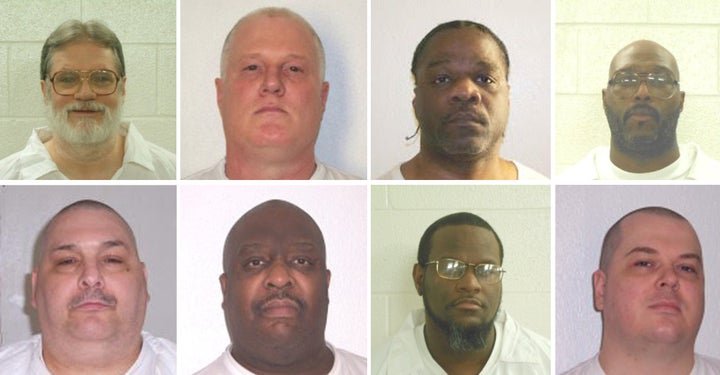
Arkansas governor Asa Hutchinson has scheduled eight executions within 10 days in April. The condemned are among 34 on Arkansas’ death row, where legal challenges have suspended capital punishment since 2005.
The men were convicted of murders between 1989 and 1999. Death penalty proponents are frustrated the cases have dragged on. Gov. Hutchinson, a moderate Republican and former federal prosecutor, is determined to reinvigorate executions.
After taking office in 2015, he scheduled executions for eight inmates, including several set to die this month. A state court halted proceedings because of a lawsuit over provisions shielding sources of lethal injection drugs. Arkansas was ordered to disclose information about its supply chain.
State’s attorney general Leslie Rutledge says the inmates have exhausted their appeals. Rutledge requested execution dates after the Supreme Court declined to review a state court ruling affirming Arkansas’ protocol.
The eight inmates are: Bruce Ward and Don Davis (April 17); Stacey Johnson and Ledell Lee (April 20); Jack Jones and Marcel Williams (April 24); and Kenneth Williams and Jason McGehee (April 27).
If all executions proceed, it will be the first time since 1997 a state has executed eight inmates in one month. Texas did so in May and June that year. No jurisdiction has executed eight in ten days.
Arkansas’ accelerated schedule will deplete its midazolam supply, which expires April 30. Attorneys challenging lethal injection procedures in state court urged the governor to reconsider the protocol. They believe Arkansas’ standing in the eyes of the world will diminish.
No state has executed two prisoners the same day using midazolam. Oklahoma tried April 29, 2014, but postponed the second procedure after Clayton Lockett’s botched execution earlier that night. Lockett’s death took an excruciating 43 minutes after midazolam was injected.
Critics claim midazolam is a sedative, not an anesthetic. Thus it is misapplied as a first-round injection. Inmates may feel pain from subsequent drugs administered.
Midazolam caused severe suffering in the executions of Dennis McGuire (Ohio), Joseph Wood (Arizona), and Ronald Smith (Alabama). In January 2017, a federal judge barred Ohio from using midazolam, saying it presented substantial, intolerable risk of serious pain. Litigation challenging Arizona’s protocol following Wood’s execution, halted that state’s use of midazolam.
In a New York Times interview, ACLU lawyer, Brian Stull, contends odds for error are greater when multiple executions are jammed together. To uphold prisoners’ rights, Stull says, “Each execution is a process that needs to be... handled with care.”
The inmates’ attorneys concede best-case scenario likely is an alternative form of execution. The three-drug concoction, they claim, is unconstitutionally cruel.
Executioners may prefer electrocution. According to Jerry Givens, Virginia’s former chief executioner, the electric chair required “far less contact with inmates” than did attaching seven tubes for lethal injection. Over 17 years, Givens executed 62 men ― 37 electrocutions, 25 lethal injections.
Gov. Hutchinson regrets executions are so closely slated. “I would love to have those extended over a period of months and years, but that’s not the circumstances.” He adds, “Families of the victims that have endured this... deserve a conclusion.”

This unprecedented spree triggers questions of how rapid-fire executions affect those present. Witnesses include loved ones of the victim and of the condemned. Attending, too, are prison personnel, pastoral counseling clergy, and reporters who function as society’s eyes.
Rendering Punishment
Justice may be blind, but those who execute it keep their eyes wide open. Administering society’s sanctions can scar those who do.
In an NPR broadcast October 12, 2000, Fred Allen, corrections officer in Huntsville, Texas, reflected how participating in 120 executions affected him. Describing post-traumatic stress disorder-like symptoms, Allen admits, “I can barely talk when I think about it.” He quit the prison after 16 years.
“Everybody has a stopping point. Somewhere down the line something will trigger memories...” Allen stops short, not wanting to dredge up flashbacks of inmates’ eyes that haunt him still.
Sister Helen Prejean, author of Dead Man Walking, recalls admonitions given witnesses at Louisiana’s Angola Prison. Wardens caution against “emotional outbursts.” No one wants witnesses celebrating executions. Strong reactions are unwelcome.
Lee Ann Gideon who covered executions for The Huntsville Item told NPR, “You’ll never hear another sound like a mother wailing whenever she’s watching her son be executed… No other sound like it. That wail surrounds the room.” She adds, “Afterward I felt numb.”
Gov. Hutchinson has discussed concerns about stacking executions and potential ill effects on prison staff, with Wendy Kelley, state corrections director. “The answer is it’s not any easier to string it over four or five months than to do it in a measured and separated fashion,” he said.
The executions come at an unsettled moment for capital punishment. Nationwide, executions have declined. While many Americans favor the sanction, polling indicates support for capital punishment waning since the mid-90s.
Evolving Community Standards
Sensibilities surrounding executions have evolved, imparting a different significance to capital punishment over time. The trend is to remove ourselves from the violence. First, physically. We no longer throw stones, the communal custom of Biblical days. Then, existentially. Average citizens have no meaningful place in the process.
This reflects growing awareness of others’ humanity, making it harder to kill criminals even if we’re convinced of guilt. Executions are formal procedures detached from community life. Once public events, executions are now the private preserve of prison personnel.
“Eliminating public executions hid their cruelty.”
“People that recommend the death penalty – the jury, the judge – if they had to perform the execution... they’d enlighten a different story on giving the death penalty to anyone,” says former executioner Givens.
Public executions, banned in New England and the Mid-Atlantic by 1845, were replaced by private, in-prison hangings. Executions were conducted before small audiences of elite citizens, obligated by etiquette to comply with decorum.
Eliminating public executions hid their cruelty. Shifting from public, passionate proceedings to cold, clinical private affairs foreshadowed modern bureaucratic executions.
Executions Behind Prison Walls
Executions are scripted so witnesses might consider them humane. Officials want proceedings to be quick, painless, private. Efficiency and speed curtail emotional clout. Executions can take minutes. Observers barely realize killing has occurred.
Lethal injection seemingly is the least painful technique yet used. This method, however, is not controversy-free. Some anesthesiologists claim injections produce paralysis that masks slow, agonizing suffocation.
In 1983, the Supreme Court [Chaney v. Heckler (718 F. 2d 1174)] commented “known evidence concerning lethal injection... indicates that... drugs pose a substantial threat of torturous pain.” When using the prescribed cocktail, the court noted, “even small error in dosages” can turn a prisoner into “a sentient witness to his own slow, lingering asphyxiation.”
Dehumanization
Contemporary procedures reflect moral void. Former San Quentin chaplain Byron Eschelman, spiritual advisor to condemned inmates, observes: “Society is expert at cold-blooded... businesslike... killing. The death penalty is routine, ritualistic... assembly-line annihilation... serving respectable citizens who pay taxes to get the job done.”
Bureaucratic protocol stifles real-life responses. Emotions distract from efficiency. Such reactions draw unwanted attention to the event’s violence.
Executioner and condemned are dehumanized. Morally numb, both reciprocate moves in a macabre dance Albert Camus called “administrative murder.”
A paradox of capital punishment is that, having attained appreciation of the condemned’s humanity, society suppresses awareness to conduct executions. The condemned is first killed by dehumanization. Then the justice system kills and disposes the body. This may be an efficient procedure. But can it be a just one?
